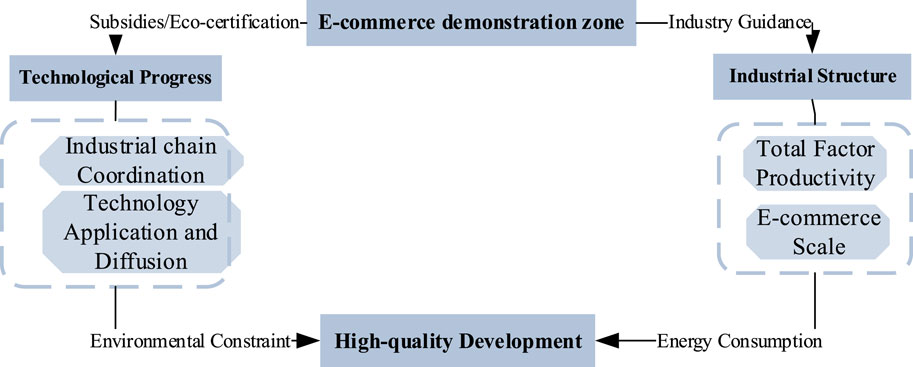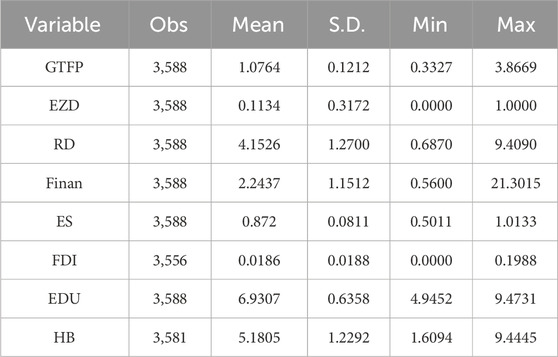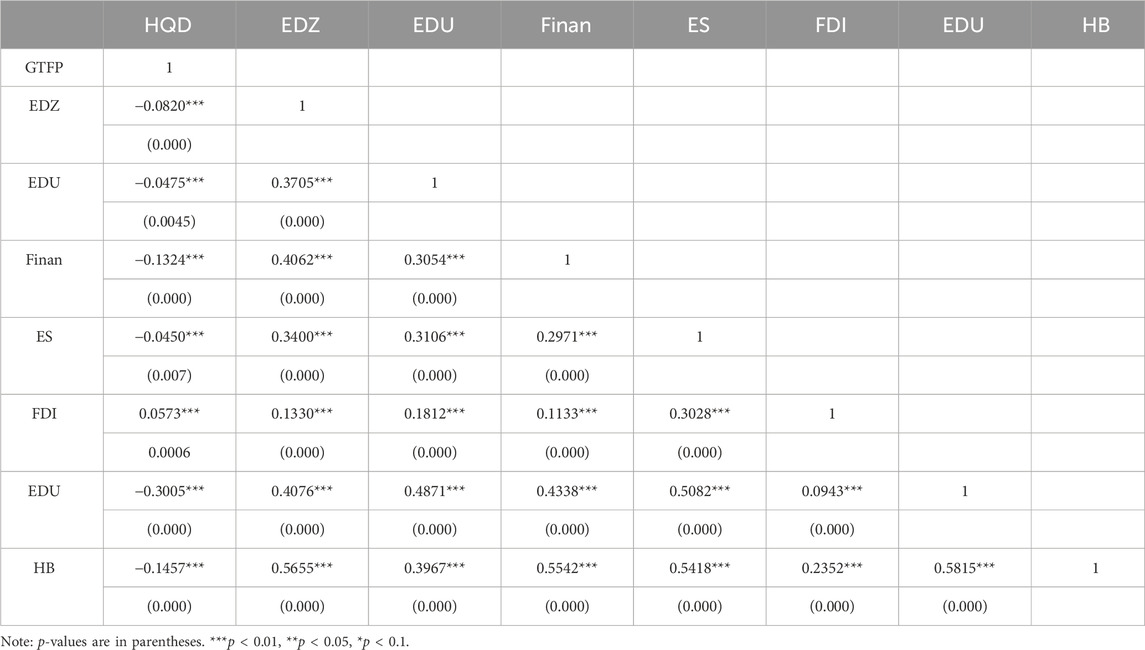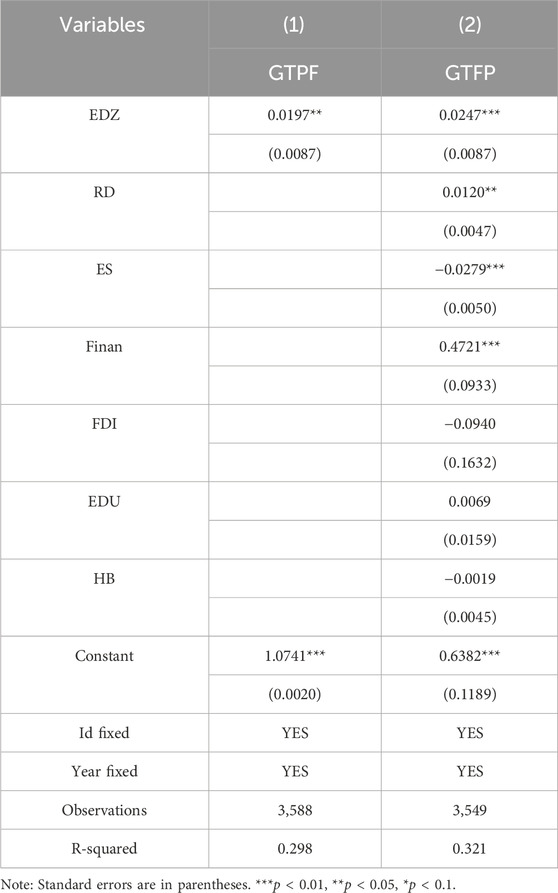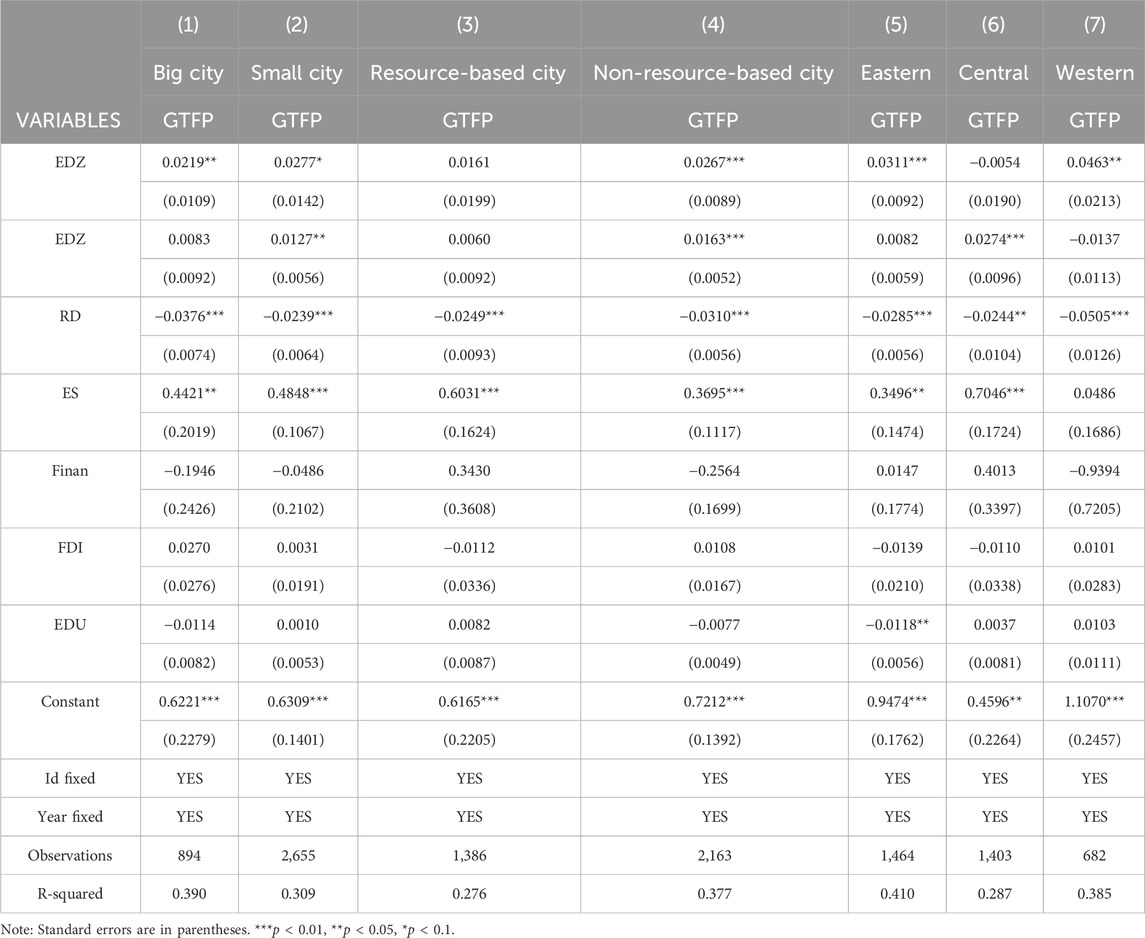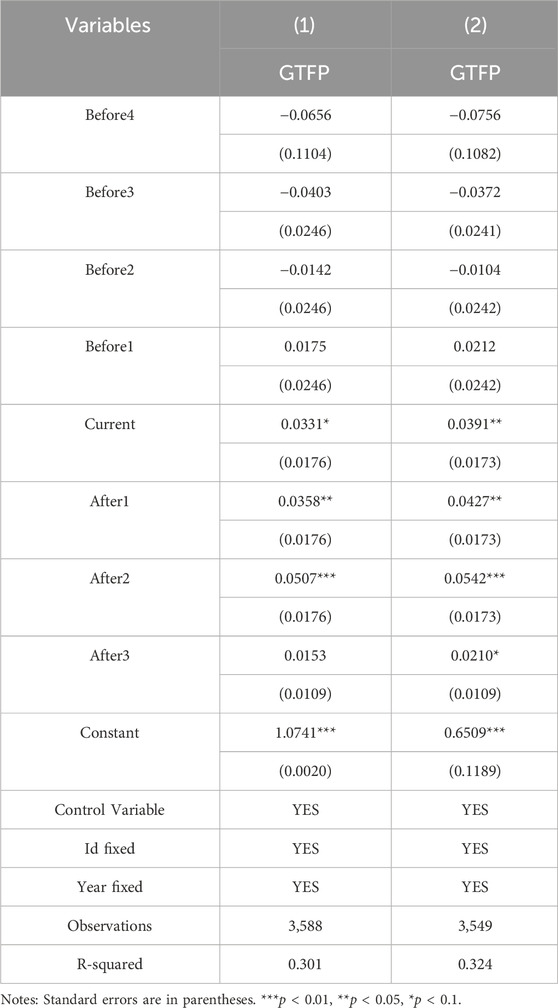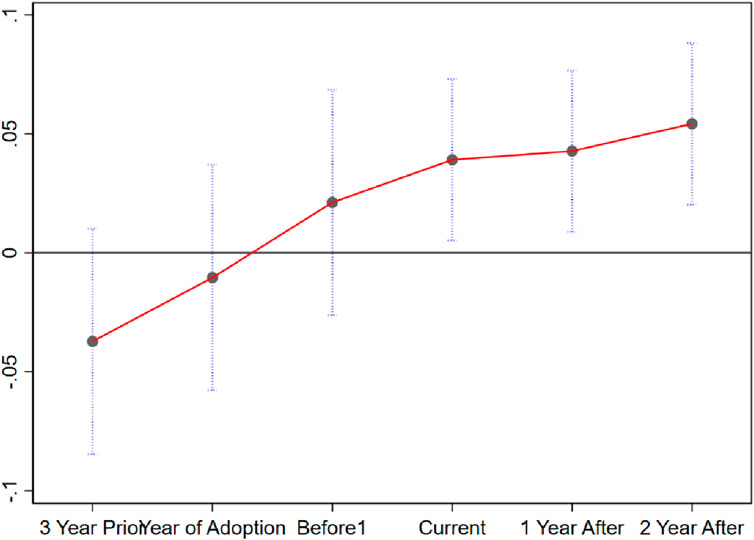- School of Economics and Management, Bengbu University, Bengbu, China
Introduction: China is exploring methods to achieve economically intensive, green, and high-quality development. Strengthening urban green total-factor production is important for achieving high-quality economic development. Whether the construction of e-commerce demonstration zones (EDZ) can provide new opportunities for high-quality urban development under the dual constraints of energy and environment is a question worth studying.
Methods: In order to verify the relationship this study using panel data from 290 prefecture-level cities in China from 2005 to 2020. Data envelopment analysis (DEA) was used to assess the level of high-quality urban development under resource and environmental constraints. The multi-phase difference-difference method (DID) was used to analyze how the e-commerce model city creation policies significantly promoted high-quality urban economic development.
Results and Discussion: This study shows that the e-commerce demonstration zone effectively promotes the high-quality development of the city. Heterogeneity tests show that the impact of electric EDZs on high-quality development can be influenced by city size and geographic location (e.g., east coast and mid-west). Based on these conclusions, this study puts forward some suggestions to enhance the attractiveness of small- and medium-sized cities, non-resource-based cities, and western cities by formulating preferential policies.
1 Introduction
Over the past 40 years, China’s economic aggregate has grown significantly from less than 5 percent of the world’s GDP to 15% and will continue to grow. In terms of GDP, China has become the second-largest economy in the world and is likely to overtake the United States as the largest economy. However, China’s rapid economic development has also resulted in serious problems such as high energy consumption, high emissions, and high pollution. The report of the 20th National Congress of the Communist Party of China stressed that high-quality development is the primary task of comprehensively building a modern socialist country. China’s economy has shifted to a stage of high-quality development, and economic and social development must promote high-quality development as a theme; thus, high-quality development has become the main concern of local government departments. With the development of the social economy and technology, e-commerce has rapidly affected every economic and social field, changing the lifestyles of residents and the production and operation modes of enterprises. E-commerce is becoming the focus of the development and growth of Chinese enterprises and is also the “overtaking track” that promotes high-quality economic development. E-commerce based on information technology and big data has gradually realized a new retail model that integrates online and offline services. E-commerce promotes consumption upgrading, which is not only a driving force for consumption but also a new potential energy source for industrial development. This has transformed consumer demand into an industry, especially after the outbreak of the novel coronavirus, which has driven the transformation and upgrading of physical enterprises. This has profoundly impacted information matching, technological innovation, logistics, and consumption. Statistics show that from 2009 to 2021, the transaction share of China’s e-commerce market increased from 3.8 trillion yuan to 42.3 trillion yuan, a growth rate of more than 10 times. E-commerce transactions accounted for 36.8% of the GDP in 2021 compared to 10.9% in 2009. E-commerce is becoming a major driving force for high-quality economic development.
The rapid development of e-commerce in recent years cannot be separated from the support for the national e-commerce demonstration city policy. Since China issued Several Opinions on Accelerating the Development of E-commerce, it has played an important role in promoting trade and investment liberalization and facilitation. In 2009, China established its first national e-commerce demonstration city, Shenzhen. In 2011, to promote the rapid development of e-commerce, China conducted e-commerce pilot work and promoted relevant e-commerce policies to achieve breakthroughs in some regions. Simultaneously, 23 cities—Beijing, Shanghai, Tianjin, Chongqing, and others—were approved as e-commerce pilot cities. Later, to fully understand the role of e-commerce in optimizing resource allocation, improving industrial structure, driving employment, and giving play to the role of demonstration cities in radiating the economic development of surrounding areas, 47 new cities such as Jinan, Shijiazhuang, and Hefei were added as e-commerce demonstration cities in 2014 and 2017.
The impact of e-commerce on high-quality development is as follows. High-quality economic development has become a trending issue in academic circles. Researchers have studied the factors affecting high-quality economic development from different perspectives, for example, Internet technology promotes (Oliner, 2003; Thompson and Garbacz, 2007; Hanafizadeh et al., 2019), industrial collaborative agglomeration (Jin, 2012; Lanaspa, 2016; Amidi and Majidi, 2020), green technological innovation (Li et al., 2019; Wilson,2012). However, research on the impact of e-commerce on economic development, especially high-quality economic development, is lacking. To date, research on the impact of e-commerce on economic development has focused on policy interpretation and analysis, with few empirical studies. In addition, few quantitative analysis studies have examined the relationship between e-commerce and emerging markets, these studies still cannot provide reliable quantitative analysis and empirical evidence (Allen and Arkolakis, 2022; Shehata and Montash, 2019; Criveanu, 2023; Xie et al., 2023).
At present, in addition to the theoretical need to answer whether the construction of e-commerce demonstration cities will promote high-quality economic development, the following questions must be solved. If the construction of e-commerce demonstration cities will affect high-quality economic development, then the impact of e-commerce on economic quality is different in different regions and cities. In the face of the coronavirus disease 2019 (COVID-19) pandemic and the impact of global competition, how can China achieve high-quality economic development? To scientifically answer the above questions, this study used SBM-DEA to measure the level of high-quality development under resource and environmental constraints and used data from 290 prefecture level cities in China from 2005 to 2020 to establish a DID model to analyze the impact of EDZ establishment on high-quality development. Answering the above questions has important theoretical value for an in-depth understanding of the influence of EDZ on economic quality and important practical significance for stable and orderly economic development.
The main contributions of this study are as follows. First, most current research on e-commerce’s promotion of high-quality economic development remains theoretical and lacks empirical approaches. This study considers the construction of national e-commerce demonstration cities as an exogenous policy impact, with national e-commerce demonstration cities as the experimental group, and non-national e-commerce demonstration cities as the control group. The multi-time point differential method (DID) was used to empirically test the causal relationship between the construction of national e-commerce demonstration cities and high-quality urban green development, evaluate the effect of national e-commerce demonstration city policies, and objectively and effectively evaluate the net policy effect of e-commerce demonstration cities. Second, from the new perspective of the e-commerce demonstration city pilot policy, this study uses a quasi-natural experiment of national e-commerce demonstration city construction to evaluate the impact of e-commerce development on green and high-quality economic development and expands the existing influencing factors of economic quality. Regarding research content, the construction of a national e-commerce demonstration city is regarded as having an exogenous policy impact, and the empirical study of the e-commerce demonstration city policy has a significant promoting effect on green and high-quality urban development. Finally, this study examines the heterogeneity of the effect of the policy on high-quality economic development in different regions, types, and cities of different sizes. The empirical results show that the policy has obvious differences in economic development in different regions, types, and cities of different sizes, expanding the academic literature on the influential factors of high-quality economic development.
2 Literature review
2.1 Connotation of high-quality development
High-quality economic development differs from economic growth. Economic growth can be divided into quantity and quality. Early economic research has focused on the growth of economic aggregates. Solow (1956) first proposed the Solow growth model. Since then, the accounting problem of total factor productivity has received extensive attention from academia and has been associated with technological progress, efficiency improvements, economies of scale, and other factors. However, rapid economic development constantly causes energy consumption and environmental issues, and high energy consumption and other problems hinder the development of regional and national economies. Feiock (2001) believes that it is difficult to simultaneously consider economic growth and environmental protection. He proposed that countries can promote economic growth while protecting the environment through policies. Krausmann (2017) believes that it is difficult to achieve both economic growth and environmental protection and proposed that it is essential to develop a more sustainable resource utilization strategy to achieve maximum economic growth. In general, the connotation of development has changed from the growth of economic quantity to a combination of quantity and structural development.
Economic growth should solve the contradiction between people’s need for a better life and unbalanced and inadequate development. Scholars generally believe that economic growth refers to positive changes and dynamic trends such as efficiency improvement, structure optimization, power transformation, stability enhancement, and welfare distribution improvement after economic growth has reached a certain stage. The focus has been on measuring the quality of economic growth (Adom et al., 2021; Kurniasih, 2017; Özkök and Çütcü,2022). Economic growth should not only pursue the expansion of economic scale; rather, high-quality economic development should include raising total factor productivity and innovation-driven development and improving security and livelihoods. Azam et al. (2023a) used panel data to study the important role of energy consumption in the economic development of developing countries. Xu et al. (2022) proposed that high-quality economic development should consider innovation efficiency, economic vitality, green development, and people’s livelihoods. Kaftan (2023) emphasized the need for stable and sustainable economic development to meet people’s diverse needs. Azam et al. (2023b) used panel cointegration method to study the impact of energy on the human development index, and believed that the impact of energy, especially fossil energy, should be considered in the human development index. Cutcu et al. (2023) analyzed the role of renewable energy in economic growth in developing countries using the co-integration test. Drawing on the research results of existing scholars, this study proposes that high-quality economic development implies the growth of economic quality and significant improvement of economic efficiency. In addition, economic growth must be maintained above a certain level. Therefore, this study adopts the green total factor productivity index to measure the level of high-quality economic development.
2.2 Driving force for high-quality economic development
Around the driving forces for high-quality economic development, scholars have primarily conducted research from perspectives such as internet applications, industrial/economic clustering, technological innovation, and financial development. However, there are still many shortcomings; for instance, there is a scarcity of research carried out from the angle of e-commerce demonstration zones, nor has there been an assessment of the impact of these zones on high-quality development. In evaluating the process of high-quality development, most studies fail to consider the dual constraints of energy and the environment.
The widespread use of Internet technology can significantly increase GDP growth (Hanafizadeh et al., 2019). Oliner (2003) considered American enterprises as a research object and found that the extensive use of Internet technology in the United States effectively improved the production efficiency of enterprises. Thompson and Garbacz (2007) studied the impact of the Internet penetration rate on enterprise production efficiency. Using data from 93 countries, they found that the Internet can significantly improve enterprise production efficiency, and this impact is more significant in developing countries. In this Internet era, inclusive growth that benefits all people can be achieved through the Internet of economic behaviors. Fan et al. (2023) believe that China has made remarkable achievements in inclusive growth and has significantly improved the pattern of income distribution. Ofori and Asongu (2021) used world development indicators to verify that the use of information technology promoted the inclusive growth of South Africa’s economy and that the diffusion of information technology promoted significant growth in South Africa’s economy. When studying the rapid economic growth of ASEAN countries, Alekhina and Ganelli (2021) analyzed transnational panel data and proposed that the application of digital technology plays a significant role in promoting inclusive economic growth. Azam et al. (2023c) uses a panel autoregressive Distributed lag (ARDL) model for the relationship between ICT and factors such as agricultural productivity, renewable energy, and human capital.
Industrial collaborative agglomeration refers to the performance of heterogeneous industries in a spatial agglomeration. Industrial collaborative agglomeration can realize intra-regional resource integration and positive interaction between industries, exert a positive externality effect, and become an important way to promote high-quality development of the regional economy (Lanaspa et al., 2016). Strong interactions between regions through trade, capital flow, and other means can form industrial clusters, leading to the rapid spread of externalities across borders, thus providing a reasonable explanation for economic growth (Amidi and Majidi, 2020). This means that regional economic growth is not only affected by the change in Internet technology but also indirectly affected by the surrounding economies, that is, by the effect of economic aggregation. Yang (2022) believes that economic agglomeration has an “allocation effect,” that is, capital tends to flow to areas with more specialized capital-intensive industries. At the same time, economic agglomeration has an “agglomeration effect”; that is, it enhances learning exchange among organizations, promotes spillover and technological innovation, and forms economies of scale.
In terms of technological innovation, Demmel (2017) found through empirical research that innovation plays an important role in enterprise productivity, especially the production efficiency of developed or developing countries, which can be significantly improved. Green technological innovation and environmental regulation have an important impact on driving high-quality economic development. Cao et al. (2020) noted that environmental regulation supports high-quality economic development through technological innovation and resource consumption. Thompson (2018) points out that technological innovation is the driving force of economic development, and its own industrial economic benefits and the spillover effects of innovative technology are key to promoting economic growth.
Considering financial development, Wu et al. (2023) evaluated the level of high-quality development in China’s Yangtze River Delta region by constructing an evaluation index system for high-quality economic development and noted that financial development can promote high-quality economic development through a spatial econometric model. Financial development is regarded as a successful means of reducing carbon emissions through effective resource allocation. Karlilar et al. (2023) conducted an empirical analysis of 36 OECD countries and noted that green innovation and financial development reduce energy consumption and environmental pollution, promote environmental sustainability, and improve production efficiency, thereby promoting green and high-quality urban development. Cutcu et al. (2023) believe that there is a causal relationship between economic activities, energy consumption and ecological environment, that is, high-quality development is in essence a coordinated development of economy, energy and environment.
2.3 E-commerce demonstration city and high-quality economic development
According to the environmental Kuznets curve, China’s traditional industries promote rapid economic development with large investments in resource factors. At this stage, economic development mainly relies on energy, labor, land, capital, and other production factors, and the production mode of high-energy consumption and the economic growth generated cannot effectively solve the problem of environmental pollution or achieve sustainable economic development. E-commerce has broken the traditional factor-dependent growth model. Under the policy guidance of e-commerce demonstration city construction, traditional industries and modern information technologies (e.g., the Internet and e-commerce) continue to penetrate and integrate, and their original production and operation modes have changed. This model is conducive to optimizing the efficiency of resource allocation, reducing costs, promoting innovation and reform, and achieving high-quality economic development.
Hypothesis 1. EDZ has a promoting effect on the high-quality development of urban economy.
E-commerce drives enterprises through technological innovations. E-commerce has led to changes in business models, value creation, and exchange methods, all of which must coordinate the network relationships of multiple market players. With the development of e-commerce and the popularization of the Internet, the number of channels through which enterprises can obtain information is increasing. E-commerce strengthens the dissemination of knowledge, transforms information and knowledge into key elements, opens markets, creates value, and earns profits from innovation and development. Internet-based e-commerce can connect upstream and downstream enterprises and use big data as a new driving force for in-depth market analysis, reducing corporate information search costs, and accurately positioning consumers to achieve business innovation. Simultaneously, e-commerce can accelerate the response speed of the enterprise supply chain, effectively control inventory levels, shorten the supply chain, and improve the efficiency of the supply chain and enterprise profitability. Improvements in profitability can help enterprises release more idle resources for R&D. In addition, the network of market players intensifies competition between enterprises, forcing them to allocate more research and development funds to improve technological innovation ability, promote the improvement of regional innovation levels, and drive high-quality economic development.
E-commerce has increased the technological content of the economy and cloud computing, the Internet of Things, and other technologies developed based on e-commerce all reflect technological innovation. The wide application of e-commerce technology will promote the intelligent development of e-commerce management technology, strengthen the concept of green development, and give birth to new energy logistics vehicles, green packaging, and digital business management systems. E-commerce applies big data, sensors, artificial intelligence algorithms, 5G cloud communication, and other technologies to e-commerce logistics management, data analysis, and other links to create a smart, green-oriented development path and industrial ecology. This enhances industrial chain coordination and promotes high-quality economic development. E-commerce promotes the application and diffusion of new technologies. In a fiercely competitive environment, enterprises continue to increase technological investment, improve technological innovation, and promote industrial upgrades through technological progress and productivity improvements (Sanaei and Sobhani, 2018). Simultaneously, e-commerce promotes the optimization and adjustment of the economic structure, changes the mode of economic development, and reduces energy consumption and environmental pollution, thus forming a green economy effect.
The development of e-commerce has significantly increased the proportion of the service industry in the national economy and promoted the upgrading of the industrial structure (Su, 2021). The industrial structure determines the pattern of energy consumption and pollution emissions to a certain extent; the energy consumption and pollution emissions of the service industry are much lower than those of capital- and energy-intensive industries. The development of a green economy has become a source of high-quality economic development, providing a new perspective for promoting industrial green upgrading, and industrial agglomeration plays an important role in regional green development. Since the outbreak of the COVID-19 epidemic, e-commerce has grown against this trend, driving the transformation and upgrading of China’s foreign trade, and exerting a profound impact on its economic development and residents’ consumption concepts. Thus, e-commerce has become an important driving force of rapid economic development. Wilson et al. (2012) believe that the establishment, maintenance, and renewal of comprehensive cross-border e-commerce pilot zones have a positive effect on regional economies.
The development of e-commerce technology will enhance the total factor productivity (TFP) of enterprises. E-commerce has created information and technology as key production factors; reduced product prices; and attracted high-end talent, advanced management methods, and integrated high-quality financial capital. Further, e-commerce can promote an increase in the proportion of technology- and knowledge-intensive industries as a whole to promote the transformation of the economic structure and realize the optimization of the industrial structure. Lastly, e-commerce can encourage the manufacturing industry to obtain consumer demand information quickly, accurately analyze market demand in intelligent production, avoid blindness and randomness of production, promote efficient resource allocation, accelerate the speed of innovation iterations, and improve the quality of product supply.
Hypothesis 2. EDZ can promote technological innovation, achieve industrial structure upgrading, and thus promote the improvement of total factor productivity and high-quality development of enterprises (Figure 1).
3 Research methods
3.1 Model setting
First, we used the difference-difference (DID) model to evaluate the impact of an e-commerce demonstration city pilot on green total factor productivity. The Difference-in-Differences (DID) is a causal inference method used in observational studies. The basic idea is to estimate the causal effect of an intervention by comparing the pre- and post-intervention changes between a treatment group that received the intervention and a control group that did not. This method can effectively control for the influence of unobservable factors on research outcomes, making it particularly suitable for studying cause-and-effect relationships under natural conditions. As a “quasi-experimental,” under the basic framework of Two-Way Fixed Effects, the standard DID model form is as Eq. (1):
Where
The time-varying DID replaces
3.2 Variable selection and data description
3.2.1 Explained variable
High-quality development (HQD). To measure the high-quality development level of the region, this study used the SBM-Malmquist index. Urban labor, capital, and energy are taken as inputs set:
where
Based on the SBM direction distance function, the dynamic change in factor utilization efficiency between the two periods was measured. The specific expressions are as Eq. (6)
Where
Referring to the research of Färe et al. (1994) and Ray and Desli (1997), the GML index is decomposed into the product of pure efficiency change (PEC), technological progress rate (PTC), efficiency of scale (SEC) and technological scale change (STC) under the assumption of constant returns to scale. The expressions are as Eq. (7):
where
3.2.2 Core explanatory variable
National E-commerce Demonstration City (SFQ). The research object of this study is 250 prefecture-level cities in China from 2005 to 2020. During the sample period, 71 cities were approved as national e-commerce demonstration cities in three successive batches (2011, 2014, and 2017).
3.2.3 Control variables
These mainly control other factors that affect the high-quality development of the region. Specifically, it includes 1) Technology research and development expenditure (RD), expressed as the proportion of RD research and development expenditure to GDP, and reflecting the level of urban R&D investment. 2) Financial development level (Finance), expressed by the proportion of deposits and loans in GDP and reflecting the degree of urban financial development. Financial development level is a necessary service sector for the development of e-commerce. 3) Economic situation (ES) expressed by the proportion of non-agricultural industrial added value to GDP. The economic situation is closely related to the development of e-commerce. 4) Foreign direct investment (FDI) which, on the one hand, brings advanced technology and sufficient capital but, on the other hand, leads to the “pollution refuge” effect. 5) Education level (EDU) which reflects regional human capital status by per capita education expenditure. 6) Environmental infrastructure (HB) which, per 10,000 environmentally friendly vehicles, reflects the region’s attention to environmental governance. Here, the more perfect the environmental infrastructure, the higher the level of high-quality development of the region.
The data in this study come from the China Statistical Yearbook and the regional statistical yearbook over the past years, and the price data are deflated using 2010 as the benchmark. To avoid the heteroscedasticity problem, non-percentage data were processed logarithmically. The descriptive statistics of the variables are presented in Table 1. As shown in Table 1, the difference between the maximum and minimum values of most indicators is small, and the mean value is greater than the standard deviation, which proves that the degree of dispersion of the data is small.
Table 2 reports the correlation between the variables. There is a significant correlation between SFQ and HQD at the level of 1%, which means that there is a close relationship between e-commerce demonstration city pilots and high-quality urban development. Most of the correlations between other variables also passed the significance level of 1% and were less than 0.6, indicating that the variables were correlated but there was no multicollinearity.
4 Analysis of empirical results
4.1 Baseline regression results
Table 3 reports the baseline regression results for DID estimates. (1) is the result of double fixed effect regression without adding control variables. The e-commerce demonstration city coefficient is 0.0197, which is significantly positive at the 5% level. After adding control variables to column (2), R2 increases, and the e-commerce demonstration city coefficient is 0.0247, which also passes the significance test. This means that there is a significant difference in the impact of setting up e-commerce demonstration cities on urban green TFP, and the level of green TFP in e-commerce demonstration cities is higher.
4.2 Heterogeneity analysis
Due to differences in city size, geographical location, resource endowment, and economic development level, the impact of e-commerce pilot cities on green total factor productivity may be heterogeneous.
First, the sample was divided into large cities and small- and medium-sized cities according to whether they belong to the 70 large- and medium-sized cities set by the National Bureau of Statistics of China. Columns (1) and (2) of Table 4 show the estimated results. The SFQ coefficient for large cities is 0.0219, with a significance level of 5%. The coefficient of non-large- and medium-sized cities is 0.0277, which is significant at the 10% level. This indicates that city size has a heterogeneous influence on e-commerce demonstrations. For big cities, the effect of setting up e-commerce demonstration cities is smaller than that for non-big cities, mainly because of the wide variety of pillar industries in big cities and because industrial transformation has been completed in recent years. While small- and medium-sized cities have weak foundations and low technical levels, the establishment of e-commerce demonstration cities can gain policy advantages.
Second, the estimation results in Columns (3) and (4) are obtained by classifying resource-based cities according to whether they were established by The State Council of China. Comparing resource-based and non-resource-based cities, the coefficient of resource-based e-commerce demonstration cities is insignificant. The estimated coefficient for non-resource-based cities is 0.0267, which is significant at the 1% level. The primary purpose of e-commerce demonstration cities is to reduce energy consumption and develop a green economy. Resource-based cities rely on their own resource endowments and the cost of e-commerce transformation is high. Non-resource-based cities have less resistance to e-commerce transformation and a more obvious impact on green total factor productivity.
Finally, the sample is divided according to the difference in economic development levels in eastern, central, and western China, and the estimated results in columns (5)–(7) are obtained. The coefficient of the central region is not significant, the coefficient of the eastern region is 0.0311, significant at the 1% level, and the coefficient of the western region is 0.0463, significant at the 5% level. The establishment of e-commerce in the western region has a more obvious impact on green total factor productivity, mainly due to the weak industrial base in the western region. Here, relying on policy support can provide a stimulating advantage.
4.3 Robustness test
4.3.1 Parallel trend test
To test the robustness of the DID results, parallel trend tests were conducted. The estimated results are presented in Table 5 and Figure 2. Because the pilot e-commerce demonstration cities were set up in batches, the coefficients of the first 4 years and the last 3 years of the policy were obtained according to the standard of the policy establishment time. Column (1) of Table 5 does not include the control variables, and the coefficients in the first 4 years of the policy are not significant.
The coefficient of the policy year is 0.0331, which is significant at the 10% level, indicating that the green total factor productivity of the e-commerce demonstration city pilot area improved significantly in the policy year. Subsequently, the coefficients 1 year and 2 years after the establishment of the policy are significantly positive, which means that the establishment of an e-commerce demonstration city pilot has a long-term effect and can positively impact regional green total factor productivity. After the control variables were added to Column (2), the coefficient test results were the same as those in Column (1); that is, before the establishment of pilot e-commerce demonstration cities, the change in green total factor productivity was not significant, and the pilot coefficient of e-commerce demonstration cities was significantly positive in the year when the policy was established and 2 years later. This directly explains the impact of the pilot e-commerce demonstration city on green total factor productivity and conforms to the parallel trend test of the DID model.
The estimated results in Column (2) of Table 5 are shown graphically in Figure 2. Before the establishment of the pilot e-commerce demonstration city, the 95% confidence interval contained zero axes. When the e-commerce demonstration city pilot was established, the coefficient was above the zero axis, and the 95% confidence interval did not contain the zero axis, indicating that the policy effect was significant. Two years after the e-commerce demonstration city pilot was established, the policy pilot had a long-term effect on green total factor productivity, and this effect showed a growing trend.
4.3.2 Placebo test
To avoid the randomness of policy selection, this study tests the randomness of pilot cities and pilot times of e-commerce demonstration cities (Figure 3). First, 1,000 random samples were taken from the pilot cities; the results are shown in Figure 3A. The coefficient of the randomly selected samples presents a normal distribution near 0, and most samples cannot meet the significance level, which means that the influence of e-commerce demonstration city pilot areas on green total factor productivity is not random. Figure 3B also verifies that the coefficients are not significant in most years, except the pilot years, by randomly sampling the pilot times of the e-commerce demonstration cities. Thus, the robustness of the e-commerce demonstration city pilot’s influence on green total factor productivity in this study is verified.
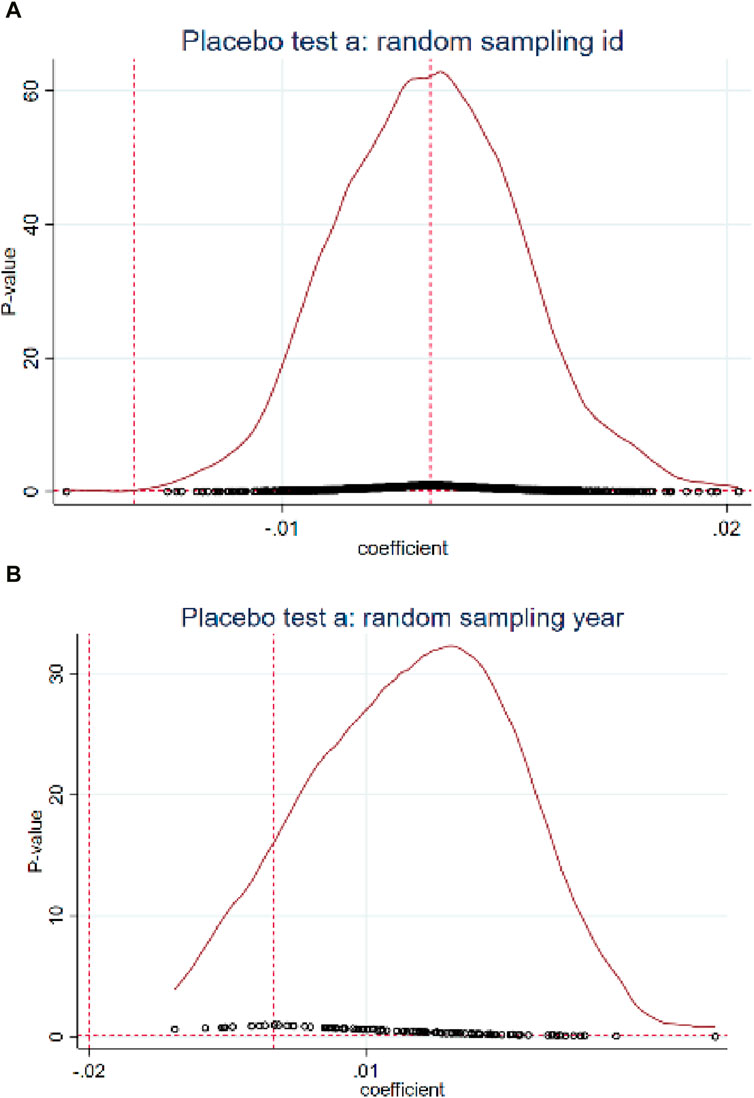
Figure 3. (A) Randomly selected areas. (B) Random selection of years Figure 2 DID placebo test.
5 Research conclusion and policy recommendations
5.1 Research conclusion
An e-commerce demonstration zone refers to certain cities or regions selected by the state that enjoy preferential policies, financial investment, technological innovation, and other aspects. The purpose is to promote the application of e-commerce and stimulate economic transformation and upgrading through demonstrative leadership and driving effects. The goal of the e-commerce demonstration zones is to form replicable and scalable e-commerce development models, optimize the industrial layout of e-commerce, improve service levels and efficiency, enhance the competitiveness of enterprises within the region, and ultimately achieve high-quality economic development.
China’s economic growth is stabilizing, but its economic growth mode needs to be reformed. Technological innovation is the key to achieving high-quality economic development. In the economic development of the 21st century, e-commerce has become an indispensable driving force. With the continuous advancement and popularization of internet technology, e-commerce has brought revolutionary changes to traditional business models, fostered innovation in consumption patterns, and had a profound impact on improving economic efficiency, promoting the optimization and upgrading of industrial structures, and facilitating balanced regional economic development. To further accelerate the growth of e-commerce, the Chinese government has implemented a policy for e-commerce demonstration cities, aiming to guide the healthy development of national e-commerce by establishing a number of exemplary cities. This article will delve into an in-depth discussion on the theme that “E-commerce Demonstration Zones Contribute to High-Quality Development."
E-commerce demonstration city construction is an important national pilot policy, and its implementation not only improves the development environment of e-commerce but also plays a role in the green economic effect of e-commerce and drives the high-quality economic development of the city. Therefore, based on a quasi-natural experiment of the national e-commerce demonstration city policy and theoretical analysis, this study uses panel data from 250 prefecture-level cities in China from 2005 to 2020 as research samples, adopts the SMM-Malmquist index to measure the high-quality development of the urban economy, and uses the dual-difference method (DID) for empirical testing. The main conclusions are as follows. Compared with non-national e-commerce demonstration cities, the construction of national e-commerce demonstration cities can significantly promote the green and high-quality economic development of pilot cities, and this promotion effect does not have a time lag. In the baseline regression, there was a significant difference in the impact of e-commerce demonstration cities on urban green TFP, and the level of green TFP in e-commerce demonstration cities was higher. In the heterogeneity test results, based on the estimation results of cities of different sizes, the establishment of e-commerce demonstration cities in small- and medium-sized cities had the greatest effect on promoting the development of the local green economy, while the effect of large cities was smaller than that of small- and medium-sized cities. Second, e-commerce demonstration cities among non-resource-based cities have a significant impact on the development level of regional green total factor productivity. Finally, from a regional perspective, the establishment of e-commerce demonstration cities improved the green total factor productivity of cities in eastern and western China, but the effect was more obvious in western China.
As an important initiative by the state to promote the development of e-commerce, e-commerce demonstration zones have shown positive effects in promoting high-quality economic development. Through efforts in innovation-driven development, green growth, market expansion, and employment increase, e-commerce demonstration zones are becoming a significant force in driving economic transformation and upgrading. However, facing challenges such as technological innovation, market regulation needs, and infrastructure improvement, e-commerce demonstration zones still need to continuously explore and improve. In the future, e-commerce demonstration zones should continue to play a demonstrative and leading role, promoting policy innovation, technological innovation, market innovation, and management innovation, contributing to the achievement of high-quality economic development.
5.2 Policy recommendations
Based on the above research conclusions, this study proposes the following suggestions.
First, the government should strengthen the construction of information-related infrastructure to form a high-quality development path that reduces energy consumption and environmental pollution. The implementation of the national e-commerce demonstration city policy can fully improve the efficiency of resource allocation, reduce environmental pollution, and promote high-quality economic development. Therefore, the government should establish corresponding institutions, take multiple measures to promote the development of the local e-commerce industry, increase investment in information technology, and continue to consolidate and improve traditional information infrastructure construction levels, such as the Internet penetration rate and fixed broadband users. We will actively promote the construction of new infrastructure, represented by 5G and digital centers, to prevent the digital divide from creating an excessive informatization gap.
Second, when selecting e-commerce demonstration pilot cities, the pilot should not be implemented blindly. We will formulate preferential policies for small- and medium-sized cities, non-resource-based cities, and Western cities to make them more attractive. Owing to the different conditions of the cities themselves, the policy formulation focus is also different. Small- and medium-sized cities lag behind big cities in capital introduction, education investment, and talent introduction; therefore, financial and human support should be given to demonstration cities in the process of policy formulation and implementation. Compared to resource-based cities, non-resource-based cities have less resistance to relying on e-commerce for transformation, and the impact on green total factor productivity is more obvious. Therefore, non-resource-based cities should make full use of their late-comer advantages, improve the e-commerce ecosystem, and rely on the technological and open innovation advantages of e-commerce platforms to accelerate their own high-quality economic development. Given its geographical disadvantage, the western region is weak in terms of talent attraction; hence, we should pay attention to the introduction of scientific, technological, and e-commerce talents and increase the cultivation of local talent to improve talent attraction.
Third, improve market supervision and legal regulations. To protect consumer rights and maintain a fair market order, e-commerce demonstration zones need to strengthen market supervision, combat false advertising, intellectual property infringement, and other irregular practices. Furthermore, relevant laws and regulations should be refined to provide a clear legal framework and protection for e-commerce transactions.
Finally, optimize infrastructure construction and logistics distribution: An efficient logistics distribution system is one of the key factors for the success of e-commerce. E-commerce demonstration zones should increase the construction of infrastructure, improve transportation networks, upgrade logistics centers, etc., while using information technology to enhance the efficiency and accuracy of logistics and distribution, providing consumers with faster and more convenient services.
This study uses Chinese urban panel data to analyze the impact of e-commerce demonstration zones on high-quality development under resource and environmental constraints. Although we obtained robust estimation results by using DID analysis method, due to the short implementation time of e-commerce demonstration zones, its impact on high-quality economic development and ways are still unclear, and theoretical and empirical analysis should be strengthened. In future studies, we will focus on the deep relationship between the two and establish a theoretical model to describe it.
Data availability statement
The original contributions presented in the study are included in the article/Supplementary Material, further inquiries can be directed to the corresponding author.
Author contributions
QG: Conceptualization, Data curation, Investigation, Methodology, Software, Writing–original draft, Writing–review and editing. NZ: Conceptualization, Data curation, Investigation, Methodology, Software, Writing–original draft, Writing–review and editing.
Funding
The author(s) declare that financial support was received for the research, authorship, and/or publication of this article. Major project of humanities and social sciences of Anhui Province education department (Grant No. SK2021ZD0095); Philosophy and social science research projects in Anhui Province (Grant No. AHSKY202145; 2022AH051899); Humanities and social science research projects in universities in Anhui Province (Grant No.SK 2020A0545).
Conflict of interest
The authors declare that the research was conducted in the absence of any commercial or financial relationships that could be construed as a potential conflict of interest.
Publisher’s note
All claims expressed in this article are solely those of the authors and do not necessarily represent those of their affiliated organizations, or those of the publisher, the editors and the reviewers. Any product that may be evaluated in this article, or claim that may be made by its manufacturer, is not guaranteed or endorsed by the publisher.
References
Adom, P. K., Agradi, M., and Vezzulli, A. (2021). Energy efficiency-economic growth nexus: what is the role of income inequality? J. Clean. Prod. 310, 127382. doi:10.1016/j.jclepro.2021.127382
Ahi, A. A., Sinkovics, N., and Sinkovics, R. R. (2023). E-commerce policy and the global economy: a path to more inclusive development? Manag. Int. Rev. 63 (1), 27–56. doi:10.1007/s11575-022-00490-1
Alekhina, V., and Ganelli, G. (2021). Determinants of inclusive growthin ASEAN. J. Asia Pac. Econ. 28, 1196–1228. doi:10.1080/13547860.2021.1981044
Allen, T., and Arkolakis, C. (2022). The welfare effects of transportation infrastructure improvements. The Review of Economic Studies 89 (6), 2911–2957.
Amidi, S., and Fagheh Majidi, A. (2020). Geographic proximity, trade and economic growth: a spatial econometrics approach. Ann. GIS 26 (1), 49–63. doi:10.1080/19475683.2020.1714727
Azam, A., Ateeq, M., Shafique, M., Rafiq, M., and Yuan, J. (2023a). Primary energy consumption-growth nexus: the role of natural resources, quality of government, and fixed capital formation. Energy 263, 125570. doi:10.1016/j.energy.2022.125570
Azam, A., Rafiq, M., Shafique, M., and Yuan, J. (2023b). Interpreting the dynamic nexus between green energy, employment, fossil fuel energy, and human development index: a panel data investigation. Energies 16 (7), 3132. doi:10.3390/en16073132
Azam, A., Shafique, M., Rafiq, M., and Ateeq, M. (2023c). Moving toward sustainable agriculture: the nexus between clean energy, ICT, human capital and environmental degradation under SDG policies in European countries. Energy Strategy Rev. 50, 101252. doi:10.1016/j.esr.2023.101252
Cao, Y., Wan, N., Zhang, H., Zhang, X., and Zhou, Q. (2020). Linking environmental regulation and economic growth through technological innovation and resource consumption: analysis of spatial interaction patterns of urban agglomerations. Ecol. Indic. 112, 106062. doi:10.1016/j.ecolind.2019.106062
Criveanu, M. M. (2023). Investigating digital intensity and e-commerce as drivers for sustainability and economic growth in the EU countries. Electronics 12 (10), 2318. doi:10.3390/electronics12102318
Cutcu, I., Beyaz, A., Gerlikhan, S. G., and Kilic, Y. (2023). Is ecological footprint related to foreign trade? Evidence from the top ten fastest developing countries in the global economy. J. Clean. Prod. 413, 137517. doi:10.1016/j.jclepro.2023.137517
Demmel, M. C., Máñez, J. A., Rochina-Barrachina, M. E., and Sanchis-Llopis, J. A. (2017). Product and process innovation and total factor productivity: evidence for manufacturing in four Latin American countries. Rev. Dev. Econ. 21 (4), 1341–1363. doi:10.1111/rode.12323
Fan, S., Huang, H., Mbanyele, W., Guo, Z., and Zhang, C. (2023). Inclusive green growth for sustainable development of cities in China: spatiotemporal differences and influencing factors Environmental Science and Pollution Research 30 (4), 11025–11045.
Färe, R., Grosskopf, S., Norris, M., and Zhang, Z. (1994). Productivity growth, technical progress, and efficiency change in industrialized countries The American economic review, 66–83.
Feiock, R. C., and Stream, C. (2001). Environmental protection versus economic development: a false trade-off? Public Adm. Rev. 61 (3), 313–321. doi:10.1111/0033-3352.00032
Hanafizadeh, P., Hatami, P., and Bohlin, E. (2019). Business models of internet service providers. Netnomics Econ. Res. Electron. Netw. 20 (1), 55–99. doi:10.1007/s11066-019-09130-7
Huang, J., Chen, J., and Yin, Z. (2014). A network DEA model with super efficiency and undesirable outputs: An application to bank efficiency in China. Mathematical Problems in Engineering, 1–14.
Jin, K. (2012). Industrial structure and capital flows. Am. Econ. Rev. 102 (5), 2111–2146. doi:10.1257/aer.102.5.2111
Kaftan, V., Kandalov, W., Molodtsov, I., Sherstobitova, A., and Strielkowski, W. (2023). Socio-economic stability and sustainable development in the post-COVID era: lessons for the business and economic leaders. Sustainability 15 (4), 2876. doi:10.3390/su15042876
Karlilar, S., Balcilar, M., and Emir, F. (2023). Environmental sustainability in the OECD: the power of digitalization, green innovation, renewable energy and financial development. Telecommunications Policy 47 (6), 102568.
Krausmann, F., Schandl, H., Eisenmenger, N., Giljum, S., and Jackson, T. (2017). Material flow accounting: measuring global material use for sustainable development. Annu. Rev. Environ. Resour. 42 (1), 647–675. doi:10.1146/annurev-environ-102016-060726
Kurniasih, E. P. (2017). Effect of economic growth on income inequality, labor absorption, and welfare in Indonesia. Econ. J. Emerg. Mark. 9 (2), 181–188. doi:10.20885/ejem.vol9.iss2.art7
Lanaspa, L., Sanz-Gracia, F., and Vera-Cabello, M. (2016). The (strong) interdependence between intermediate producer services’ attributes and manufacturing location. Econ. Model. 57, 1–12. doi:10.1016/j.econmod.2016.04.010
Li, F., Frederick, S., and Gereffi, G. (2019). E-commerce and industrial upgrading in the Chinese apparel value chain. J. Contemp. Asia 49 (1), 24–53. doi:10.1080/00472336.2018.1481220
Ofori, I. K., and Asongu, S. A. (2021). ICT diffusion, foreign direct investment and inclusive growth in Sub-Saharan Africa. Telematics Inf. 65, 101718. doi:10.1016/j.tele.2021.101718
Oliner, S. D., and Sichel, D. E. (2003). “Information technology and productivity: where are we now and where are we going?,” in Journal of policy modeling (Boston, MA, USA: Springer US), 25, 477–503.5
Özkök, Y., and Çütcü, İ. (2022). Does fiscal federalism matter for economic growth? Evidence from the United States. Appl. Econ. 54 (24), 2810–2824. doi:10.1080/00036846.2021.1998337
Paunov, C., and Rollo, V. (2016). Has the internet fostered inclusive innovation in the developing world? World Dev. 78, 587–609. doi:10.1016/j.worlddev.2015.10.029
Ray, S. C., and Desli, E. (1997). Productivity growth, technical progress, and efficiency change in industrialized countries: comment The American economic review 87 (5), 1033–1039.
Sanaei, M. R., and Sobhani, F. M. (2018). Information technology and e-business marketing strategy. Inf. Technol. Manag. 19 (3), 185–196. doi:10.1007/s10799-018-0289-0
Shehata, G. M., and Montash, M. A. (2019). Driving the internet and e-business technologies to generate a competitive advantage in emerging markets: evidence from Egypt. Inf. Technol. People 33 (2), 389–423. doi:10.1108/itp-10-2017-0360
Solow, R. M. (1956). A contribution to the theory of economic growth. Q. J. Econ. 70 (1), 65–94. doi:10.2307/1884513
Su, J., Su, K., and Wang, S. (2021). Does the digital economy promote industrial structural upgrading? a test of mediating effects based on heterogeneous technological innovation. Sustainability 13 (18), 10105. doi:10.3390/su131810105
Thompson, H. G., and Garbacz, C. (2007). Mobile, fixed line and Internet service effects on global productive efficiency. Inf. Econ. Policy 19 (2), 189–214. doi:10.1016/j.infoecopol.2007.03.002
Thompson, M. (2018). Social capital, innovation and economic growth. J. Behav. Exp. Econ. 73, 46–52. doi:10.1016/j.socec.2018.01.005
Wilson, J. S., Mann, C. L., and Otsuki, T. (2003). Trade facilitation and economic development: a new approach to quantifying the impact. World Bank Econ. Rev. 17 (3), 367–389. doi:10.1093/wber/lhg027
Wu, K., Jiao, L., and Chen, Y. (2023). Research on the spillover effect of financial development on high-quality economic development based on 27 cities in the Yangtze River Delta. Acad. J. Bus. Manag. 5 (5), 106–112.
Xie, H., Chang, S., Wang, Y., and Afzal, A. (2023). The impact of e-commerce on environmental sustainability targets in selected European countries. Econ. Research-Ekonomska Istraživanja 36 (1), 230–242. doi:10.1080/1331677x.2022.2117718
Xu, W., Yi, J., and Cheng, J. (2022). The heterogeneity of high-quality economic development in China’s mining cities: a meta frontier function. Int. J. Environ. Res. Public Health 19 (11), 6374. doi:10.3390/ijerph19116374
Yang, H., Xu, X., and Zhang, F. (2022). Industrial co-agglomeration, green technological innovation, and total factor energy efficiency. Environ. Sci. Pollut. Res. Int. 29 (41), 62475–62494. doi:10.1007/s11356-022-20078-4
Keywords: e-commerce demonstration zone, high quality development, green development, energy constraints, green total factor productivity, data envelopment analysis
Citation: Guo Q and Zhang N (2024) High-quality development under energy constraints: an empirical study based on e-commerce demonstration zones. Front. Energy Res. 12:1373847. doi: 10.3389/fenrg.2024.1373847
Received: 20 January 2024; Accepted: 20 March 2024;
Published: 17 April 2024.
Edited by:
Boyang Shen, University of Cambridge, United KingdomReviewed by:
Ibrahim Cutcu, Hasan Kalyoncu University, TürkiyeAnam Azam, Fraunhofer Institute for Systems and Innovation Research ISI (FHG), Germany
Copyright © 2024 Guo and Zhang. This is an open-access article distributed under the terms of the Creative Commons Attribution License (CC BY). The use, distribution or reproduction in other forums is permitted, provided the original author(s) and the copyright owner(s) are credited and that the original publication in this journal is cited, in accordance with accepted academic practice. No use, distribution or reproduction is permitted which does not comply with these terms.
*Correspondence: Qian Guo, YmJ4eXNkc0AxNjMuY29t
 Qian Guo
Qian Guo Na Zhang
Na Zhang